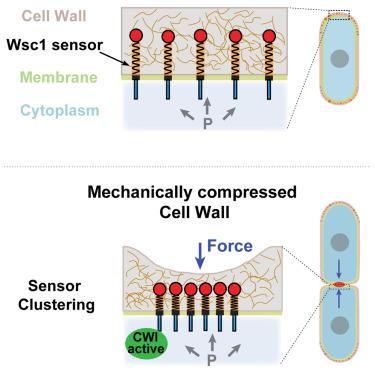Developmental Cell ( IF 11.8 ) Pub Date : 2021-10-18 , DOI: 10.1016/j.devcel.2021.09.024 Ramakanth Neeli-Venkata 1 , Celia Municio Diaz 1 , Ruben Celador 2 , Yolanda Sanchez 2 , Nicolas Minc 1

|
Surface receptors of animal cells, such as integrins, promote mechanosensation by forming clusters as signaling hubs that transduce tensile forces. Walled cells of plants and fungi also feature surface sensors, with long extracellular domains that are embedded in their cell walls (CWs) and are thought to detect injuries and promote repair. How these sensors probe surface forces remains unknown. By studying the conserved CW sensor Wsc1 in fission yeast, we uncovered the formation of micrometer-sized clusters at sites of force application onto the CW. Clusters assembled within minutes of CW compression, in dose dependence with mechanical stress and disassembled upon relaxation. Our data support that Wsc1 accumulates to sites of enhanced mechanical stress through reduced lateral diffusivity, mediated by the binding of its extracellular WSC domain to CW polysaccharides, independent of canonical polarity, trafficking, and downstream CW regulatory pathways. Wsc1 may represent an autonomous module to detect and transduce local surface forces onto the CW.
中文翻译:

通过酵母细胞壁机械传感器 Wsc1 检测表面力
动物细胞的表面受体,如整联蛋白,通过形成簇作为传递张力的信号中心来促进机械感觉。植物和真菌的有壁细胞也具有表面传感器,长细胞外结构域嵌入其细胞壁 (CW),被认为可以检测损伤并促进修复。这些传感器如何探测表面力仍然未知。通过研究裂变酵母中保守的 CW 传感器 Wsc1,我们发现了在 CW 上施加力的部位形成微米级簇。簇在 CW 压缩的几分钟内组装,与机械应力呈剂量相关性,并在松弛时分解。我们的数据支持 Wsc1 通过降低横向扩散率积累到机械应力增强的部位,由其胞外 WSC 结构域与 CW 多糖的结合介导,独立于规范极性、运输和下游 CW 调节途径。Wsc1 可以代表一个自主模块,用于检测局部表面力并将其转换到 CW 上。



























 京公网安备 11010802027423号
京公网安备 11010802027423号